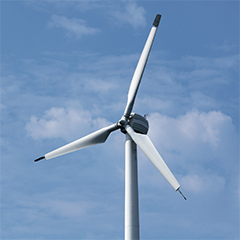Preventing efficiency loss with enhanced leading edge protection
The relentless focus on maximizing efficiency in renewable energy is a key driver in the development of both onshore and offshore wind energy equipment. From increasing blade sizes to minimizing friction in the gearbox, every aspect of wind generation has been optimized to provide maximum efficiency when the turbine is built. Attention is now shifting from efficiency at the point of manufacture, to efficiency over the lifetime of the wind turbine. One critical issue impacting this is erosion of the leading edge of the wind turbine blades by precipitation and spray.
When rotating at maximum speed, offshore wind turbine blades can reach a speed of over 90 meters per second at the tip, turning usually harmless rain droplets into high-speed impactors generating shockwaves that can seriously erode the leading edge of the wind turbine blade. With standard resin and gel coating applied during manufacturing, wind turbine blades operating in areas of high precipitation require regular replacement to prevent the turbine suffering a significant decrease in power output and efficiency.
Replacing blades showing signs of erosion is a credible option to maintain efficiency but is extremely costly, and a trade-off between cost and efficiency is usually considered. Advances in rain erosion protection in the form of sheets or ‘skins’, which can be applied to the blade post-manufacture, mean that this trade-off can be delayed by many years and could even be avoided completely by finding a solution that can prevent rain erosion. Therefore, it is important to develop high-performance erosion protection to ensure consistent efficiency and power output throughout a windfarm’s operational lifetime.
Nanocomposites for next-generation rain erosion solutions
Recognizing that polyurethane holds great promise in protection of wind turbine blade leading edges, Trelleborg’s applied technologies operation in Retford, England, developed a novel nanocomposite solution building upon experience manufacturing leading edge protection for aerospace applications that incorporated nanotubes during manufacture. It was predicted that this would reinforce the leading edge of wind turbine blades by bridging potential erosion cracks, preventing future larger pitting and mass loss.
In order to test this hypothesis, a number of sample sheets were manufactured of varying compositions, including standard polyurethane leading-edge protection material, which is currently widely used in aerospace and renewables, and a newly created carbon nanotube impregnated polyurethane.
Each of these sheets was adhered to a fiberglass blade composite substrate as per DNV-RP-0171 standard practice and tested on a state-of-the-art rain erosion rig. An accelerated erosion test, where water droplets added to the test chamber bombarded blades rotating at rapid speeds, enabled accurate comparison of test subjects. This allowed a lifetime analysis based upon precipitation rate, using the incubation period, which is the time elapsed before the first mass loss of the coating or until the damage is visually detectable, of the sample versus number of droplets impacted.
Preventing efficiency loss with enhanced leading edge protection
The relentless focus on maximizing efficiency in renewable energy is a key driver in the development of both onshore and offshore wind energy equipment. From increasing blade sizes to minimizing friction in the gearbox, every aspect of wind generation has been optimized to provide maximum efficiency when the turbine is built. Attention is now shifting from efficiency at the point of manufacture, to efficiency over the lifetime of the wind turbine. One critical issue impacting this is erosion of the leading edge of the wind turbine blades by precipitation and spray.
When rotating at maximum speed, offshore wind turbine blades can reach a speed of over 90 meters per second at the tip, turning usually harmless rain droplets into high-speed impactors generating shockwaves that can seriously erode the leading edge of the wind turbine blade. With standard resin and gel coating applied during manufacturing, wind turbine blades operating in areas of high precipitation require regular replacement to prevent the turbine suffering a significant decrease in power output and efficiency.
Replacing blades showing signs of erosion is a credible option to maintain efficiency but is extremely costly, and a trade-off between cost and efficiency is usually considered. Advances in rain erosion protection in the form of sheets or ‘skins’, which can be applied to the blade post-manufacture, mean that this trade-off can be delayed by many years and could even be avoided completely by finding a solution that can prevent rain erosion. Therefore, it is important to develop high-performance erosion protection to ensure consistent efficiency and power output throughout a windfarm’s operational lifetime.
Nanocomposites for next-generation rain erosion solutions
Recognizing that polyurethane holds great promise in protection of wind turbine blade leading edges, Trelleborg’s applied technologies operation in Retford, England, developed a novel nanocomposite solution building upon experience manufacturing leading edge protection for aerospace applications that incorporated nanotubes during manufacture. It was predicted that this would reinforce the leading edge of wind turbine blades by bridging potential erosion cracks, preventing future larger pitting and mass loss.
In order to test this hypothesis, a number of sample sheets were manufactured of varying compositions, including standard polyurethane leading-edge protection material, which is currently widely used in aerospace and renewables, and a newly created carbon nanotube impregnated polyurethane.
Each of these sheets was adhered to a fiberglass blade composite substrate as per DNV-RP-0171 standard practice and tested on a state-of-the-art rain erosion rig. An accelerated erosion test, where water droplets added to the test chamber bombarded blades rotating at rapid speeds, enabled accurate comparison of test subjects. This allowed a lifetime analysis based upon precipitation rate, using the incubation period, which is the time elapsed before the first mass loss of the coating or until the damage is visually detectable, of the sample versus number of droplets impacted.
To read the full content,
please download the PDF below.



























